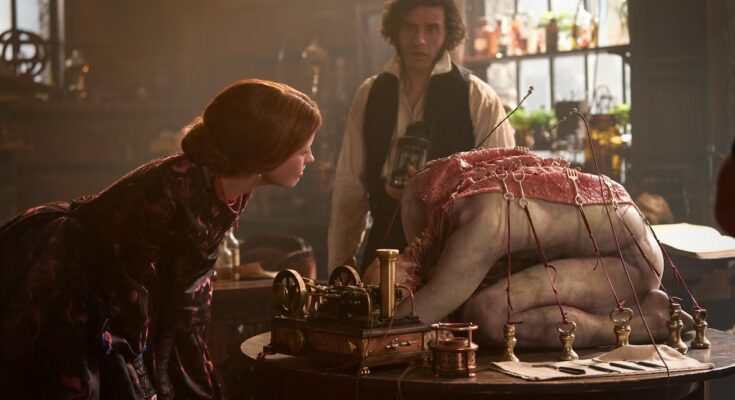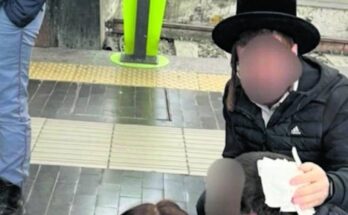Salamanca illustrator Tomás Jr. says he doesn’t manage the notion of time well. Perhaps this is why he drew with such precision some typical letters of the 19th century: the ones with which Frankenstein – in Guillermo del Toro’s new film – learned new words. “The images are made as engravings on linoleum,” explains Hijo, “a technique that consists of creating a relief on the surface.” In the era in which the film is set, “they would definitely be made of wood and printed with a press.” It is not the first time that the illustrations or engravings of this 51-year-old Spaniard have insinuated themselves into a work by the Mexican filmmaker. “It’s wonderful how you look for a specific artist for each of the roles in a film,” he says. In his case, his work led him to be Guillermo del Toro’s “specialist in letters and engravings”.
The bond between the two began almost by chance, through a Hollywood art gallery that organized exhibitions dedicated to icons of popular culture (it is difficult for him to specify the year). “By chance of life I found myself collaborating with one of them,” recalls the illustrator. There, among homages to Mario Bros or the Teenage Mutant Ninja Turtles, an exhibition dedicated to the work of the Mexican director was set up, Guillermo del Toro: In the Service of Monsters. For that occasion, Hijo created an engraving inspired by Pan’s Labyrinth (2006), a fictional piece he invented himself as if it were an old board game made in Valencia during the Civil War. The fictional story concluded with the “supposed bombing of the factory and with Del Toro finding the game and using it as inspiration for his film.”
The story was so convincing that the director himself purchased the work for his personal collection. “From there he started following me on social networks,” says Hijo. “He also shared some of my work, which I was very excited about because he is one of my favorite directors. I have been following him very closely ever since The Devil’s Backbone (2001)”, he says, confessing that it was a (horror) film that had a “very big” impact on him. “For me, Del Toro is an incredible reference.” From that exhibition, they began exchanging messages and commissions. First, the director asked him to design his ex libris —a seal placed inside a book to identify its owner—and other engravings.
They later met in Paris, where the idea was born Taurus Tarota project based on the Mexican cinematic universe and which consolidated their collaboration. Next, inside The alley of lost souls (2021), other Tarot cards designed by Son became an essential element of the plot. “Del Toro didn’t want it to be a commercial deck,” Son recalls over the phone, “so we designed one specifically for this film.” These works were enough for the three-time Oscar winner, two for best director and two for the film The shape of water (2018) and one for Best Animated Film for Pinocchio (2023) – said of the Spaniards: “Tomás Jr. is, in my opinion, one of the greatest modern printmakers. His work is vital and modern, but is rooted in a great tradition.”
I am IMMENSELY proud to have contributed a cell to that living, dazzling, glorious being that is the “Frankenstein” of @RealGDT.
These are the reading cards that appear in the cabin sequence. They’re very cute, Guillermo, with their notches and everything!(Continue)-> pic.twitter.com/uoFQuas0ZE
— Tomás Jr. (@tomashijo) November 9, 2025
Therefore, when the new project of FrankensteinThe son received another assignment: to design pedagogical cards with which the child learns certain words by observing the lessons of a grandfather to his granddaughter. “The instructions were very precise,” he says, “they were supposed to be round cards, each with a letter of the (German) alphabet and an associated icon.” On the back he added an image of a green man, a nod to the forest spirit that runs through the entire sequence. “Guillermo told me exactly which letter I should illustrate and what element to accompany it, and I developed the entire graphic from there.”
The level of detail was such that we even thought about how the character, with limited vision, could recognize each card. “We wondered how he could identify the letters without seeing clearly,” he says. “The solution was to create notches in the outline, which can be seen in the film, and which allow each card to be recognized by touch.” This obsession with visual and narrative coherence is one of the reasons why Hijo feels such an affinity with the director. “For everything he looks for a specific artist. He doesn’t entrust everything to an internal team, but selects someone who he thinks is ideal for the task.”
In addition to his film work, Hijo has published numerous picture books and this year launched his own edition of Frankenstein with the Minotauro publishing house (of the Planeta group). “It’s my Frankenstein year,” he says, “because between the movie and the book, by Mary W. Shelley, it allowed me to immerse myself in this wonderful story.” His professional career is almost at collage: “I studied journalism, but I never worked. I dedicated myself to drawing. I started with school books and children’s stories, until little by little I moved towards the realm of fantasy, horror and science fiction. That’s where I feel most at home,” he explains.
The illustrator does not hold back his enthusiasm. A moment before the phone call with this newspaper – which operates from Ávila, where he will present the illustrated book The soft stone (Random House), which he made with director Rodrigo Cortés, posted on social networks: “Thanks for having me on board, Guillermo!”



